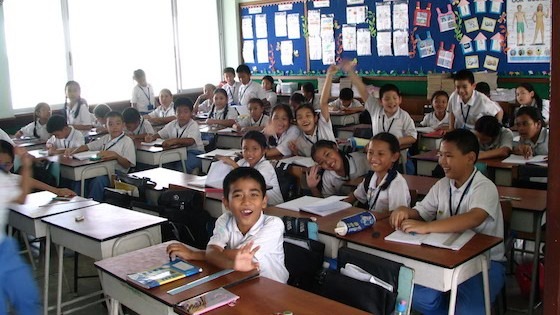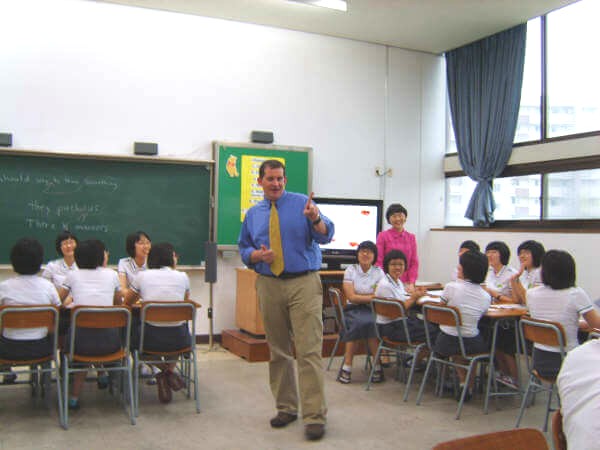Bridge graduate and author, Coleen Monroe, has taught classes of all sizes in Chile, South Korea, Vietnam, and now China. She shares her tried-and-true advice, especially for newbies, for teaching large ESL classes of young learners and teens.
It can be overwhelming to be a new teacher in front of a big class or 40-50 young English students. The classroom may have moveable furniture, a homeroom teacher whose regular class is being interrupted, or a wild-eyed group of first-grade “runners” plotting their escape. However, it’s a good idea to be prepared to teach these types of classes, as public schools in many parts of the world now integrate native speaker-taught English classes into the national curricula. These changes make it more likely that you will find yourself teaching large ESL classes of kids or teenagers during your time abroad.
If this is the case, don’t panic. Take these 7 tips to heart and be brave, and you’ll make teaching a big class meaningful and even efficient.
If you’re new to teaching, you’ll want to get initial training and qualification with a TEFL certificate. You can explore our online TEFL courses to get started!
1. Don’t expect silence when teaching large ESL classes
People make noise just by existing. And in a room full of kids, the noise level is going to be even louder. When teaching young learners, there isn’t much to be said for forcing silence on your classes for instruction since many classroom noises are unavoidable (think rustling papers, clicking pencils, random audio from neighboring classrooms, etc). Instead, try to adapt to the noise level and push for relative quiet over total silence.
2. Memorize your lesson plans or keep them simple
Although planning lessons is key to success as a teacher, you don’t want to rely too heavily on the paper itself during a large-class lesson. Don’t take significant time to look down at your lesson plan during class or the kids will start to get antsy. It’s important to have ESL classroom routines with young students and to keep it simple for your own sanity. Follow these tips:
Note: If you just want to watch the world burn, initiate a game of “Pass the Card” (which is Pass the Parcel with flashcards) using the loudest music you can find. Watch the students go absolutely berserk and suddenly find themselves unable to pass a flashcard without screeching with happiness. Don’t try to get the class back on track after that.
Get more ESL games and activities for kids.
3. Pack a classroom into a backpack for easy transport
Classroom supplies may or may not be available to you if you are teaching large classes. That’s because in general, this type of teaching requires that you move from one teacher’s classroom within a school to another and set up your lessons without using many of the materials in the classrooms.
Therefore, it’s a good idea to invest in a backpack full of your own supplies to carry with you at all times. You might include chalk/whiteboard markers, a small, portable speaker, a USB, and a pack of pencils. Additional useful supplies are playing cards, stickers, a stamp for homework, and mini-alphabet cards.
4. Spare your speaking voice with creative techniques
Don’t care for public speaking? Sorry, that’s what teaching large classes is, at its core. Teaching a schedule of large classes will inevitably test your vocal cords, even if you never raise your voice in frustration in the classroom. Thirty to fifty young people simply existing in a room together makes a lot of noise!
As a teacher in Vietnam, I once used a decibel-reading application on my phone to measure the levels of noise in the room. Resting volume was about 80 decibels, or as loud as a diesel engine. One of my classes clocked out at 120 decibels during a game, which is approximately as loud as a police siren.
Your voice cannot compete directly with that level of loud, but there are techniques to help you gain and retain the attention of the kids without developing vocal polyps. An easy one that works best on the youngest learners is to drop your volume to a whisper or just above. They won’t be able to hear what you’re saying and, assuming that they care about what you’re saying, they will naturally quiet down to be able to hear.
5. Use disruptive students to your advantage when teaching large ESL classes
Playing a team game? Make the disruptive student the scorekeeper. Doing a test? Keep the ones who want to talk busy with helping you staple the test papers together. Give disruptive students the attention and recognition that they likely crave desperately (which is why they are acting out in the first place), but with an eye to establishing clear roles and boundaries.
Learn how to effectively teach 5 challenging student types.
You can also choose the “so what?” attitude, and ignore disruptive behavior, assuming that it’s not threatening you or anyone else. Some kids want any adult attention, positive or negative, so they’ll do anything to get noticed by the teacher. Giving them an “Okay, so?” when they act out can diffuse the situation without shaming them or reinforcing the bad behavior.
6. Dress more like a stereotypical teacher
In a large class, teaching is much more of a performance – and you need the right costume. Research suggests that people behave differently when they’re dressed up as a professional (i.e. police officer, doctor) and that those who perceive others as professionals react differently to them as well.
Use this psychological bias to your advantage by dressing like a professional teacher who is in control of the classroom. Pinterest has a ton of ideas for teachers’ wardrobes. For men, wearing button-down shirts and slacks can work; for women, wearing tailored separates and higher-quality fabrics will make you look the part.
Note: In an emergency, wearing glasses instead of contact lenses can make you look (and therefore feel) more academic.
7. Can’t remember all the students’ names? Give nicknames!
If your schedule is full of large classes, it’s quite possible that you will see more than 700 students per week. This is a lot of people to remember, but it gets even worse if they all chose the English name Eric or happen to share a last name.
It can help to give nicknames that are in alignment with their personalities. For example, I nicknamed a student “Silent Surprise” because she was mostly quiet but could bring the hammer down when the boys pushed her too far. I nicknamed a student as “Wellington” because he had spent time in Wellington, NZ. I even had a student I jokingly called “Sample Text” because he wrote a whole English project with “insert sample text” as the body paragraph.
Of course, it’s up to you to gauge the class and the student when it comes to nicknames. Use your best judgment to keep the names fun and also make sure the name is appropriate for school and doesn’t lead to bullying from other students.
Teaching large ESL classes requires a similar skill set to teaching smaller ones, but a few adjustments can make a huge difference in your classes. Use performative teaching and strategic planning to your advantage, and in no time you’ll have your big classes down pat.












